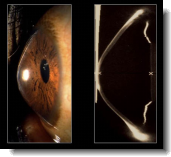
Keratoconus: What is it?
Symptoms You May Experience:
Examination: What Your Eye Doctor Will Look For:
What You Can Do:
When To Call Your M.D.:
Treatment:
Prognosis: Will I See Better?
The cornea is the clear, dome-shaped surface that covers the front central area of the eyeball and focuses light on the retina. In keratoconus the cornea is abnormally shaped because its middle area is thin and bulges out, resulting in a cone shape rather than a smoothly curved cornea. Mild cases may cause distorted vision because of the cornea's shape. In moderate or severe keratoconus, the thinned cornea can develop tiny cracks that lead to corneal swelling and eye pain (acute hydrops). Scarring of the cornea can also occur.
In the United States keratoconus occurs in about 1 of every 2,000 people, most of whom are diagnosed in their teens or early twenties. The shape of the cornea in keratoconus tends to stabilize after young adulthood. When present, keratoconus is almost always found in both eyes, but one eye may be worse than the other. The cause of the disease is not known, but keratoconus can run in families and has been linked to frequent eye rubbing, long term use of contact lenses, Down syndrome, and other rare diseases.
In the United States keratoconus occurs in about 1 of every 2,000 people, most of whom are diagnosed in their teens or early twenties. The shape of the cornea in keratoconus tends to stabilize after young adulthood. When present, keratoconus is almost always found in both eyes, but one eye may be worse than the other. The cause of the disease is not known, but keratoconus can run in families and has been linked to frequent eye rubbing, long term use of contact lenses, Down syndrome, and other rare diseases.
You may have trouble seeing clearly even with a new eyeglass prescription, and your prescription may change significantly between regular eye exams. If you wear contact lenses, the lenses may easily fall out of your eyes.
The eye doctor will examine the shape of your cornea with a slit lamp and look for thin or steep areas. Specialized photographs of the cornea called corneal topography may be taken to measure the cornea's steepness and shape.
Reduce the number of hours you wear contact lenses and avoid rubbing your eyes excessively. Keeping up with regular eye exams can help your eye doctor notice if your glasses prescription changes rapidly.
If you notice decreased vision despite a new eyeglass prescription, you should call your eye doctor. If you have keratoconus and experience eye pain, excessive tearing, or decreased vision, call your eye doctor, since these symptoms could mean that your cornea has thinned to a certain point and needs treatment.
In mild keratoconus, properly prescribed eye glasses or, more commonly, hard contact lenses usually improve vision by compensating for the steepness of the cornea. Episodes of acute hydrops may be treated with eye drops or a soft contact lense. In moderate or severe keratoconus, a corneal transplant may ultimately be needed.
Most keratoconus patients do extremely well with hard contact lenses. If corneal transplantation is necessary, these patients tend to heal well, and many experience good vision afterward.
Above: Example Of Keratoconus (Click For Bigger View-Warning:Graphic)
Contact Lenses | Glaucoma | Just For Fun | Eyeglasses | Eye Doctor | Eye Care And Symptoms | Eye Anatomy | Online Eye Tests | Laser Eye Surgery | Laser Eye Surgery Directory: Canada | Laser Eye Surgery Directory: USA | Laser Eye Surgery Reviews | Submit A Review | Contact Us | Privacy Policy | Sitemap
Copyright 2006-2009 Vision Health


